Start of the 1814 campaign of the year. Part of 2. Battle of Brienne
Allied Forces. Allied plans
During a rather long standing at the Rhine, the Allied forces increased significantly. Prussian, Austrian and Russian troops received reinforcements. The German monarchs, the former allies of Napoleon, put up their contingents against him. Thus, the army of Barclay de Tolly grew from 40 thousand to 60 thousand soldiers. The Langeron Corps brought to 40 thousand people. The Osten-Sacken Corps, which had about 10 thousand people after the Leipzig battle, increased to 20 thousand people. The rulers of the former Rhine Union exhibited 145 thousand people, who were divided into six corps. Bavaria and Württemberg set up separate enclosures. In addition, in the Rhineland territories, militias (landver) began to be formed, their numbers reaching about 145 thousand people. The German princes were indebted to 44,2 million francs (about 12 million silver rubles), which they sent to maintain the allied armies.
The Allied forces were still divided into three armies: the Main, Silesian (Blyukherovu) and Northern. The northern army participated in the campaign only partially. The main army was still commanded by Schwarzenberg. It consisted of: Austrian troops (1, 2, 3 corps and other units), Russians (Wittgenstein corps, Ermolov Guards corps, Rayevsky grenadier corps and other units), Prussian Guard, Bavarians (1 th German Allied Corps) and Württemberg (7-st German Allied Corps). All in all, the Main Army initially had up to 200 thousand people: 92 thousand Austrians, more than 61 thousand - Russians, Bavarians - 25 thousand, Wurttembergians - 14 thousand, Prussians - about 6 thousand people. In addition, 6 and 8 allied German corps were to join this army, in total about 20 thousand people.
The army of Blucher included Russian corps of Lanzheron and Saken, and Prussian corps of York and Kleist. The army had 96 thousand people (Russian - 56 thousand people, Prussian - 40 thousand people). The 4 of the German Allied Corps (Hessian) and the 5 of the German Consolidated were to strengthen the army. They numbered more than 20 thousand soldiers.
Of the Northern army, only the Russian corps of Wintzingerode and the Prussian corps of Bülow (about 66 thousand people) participated in the march to France. One brigade from the Bülow Corps, the 3 of the German Allied Corps and the 10 of the British, were to occupy Belgium and Holland. In the future, the Swedish troops and the 2 of the German corps were to approach the borders of France. In total, the Northern Army numbered about 180 thousand soldiers.
Field Marshal Blucher on the night of the new 1814 year crosses the Rhine River near the town of Kauba. Artist Wilhelm Kamphausen.
Allies fielded more than 500 thousand people with 1600 guns against France. With reserves, Allied forces numbered more than 800 thousand people and 2 thousand guns. This is not counting the troops that operated in Italy and in Spain. The reserve troops included: the German Landwehr - about 100 thousand people; Austrian reserve - 20 thousand people; Bennigsen's army - 35 thousand people; Lobanov-Rostovsky army - 60 thousand people; 4 th Prussian Corps - 50 thousand people; Prussian reserve building - 20 thousand; Russian-Prussian troops who besieged Glogau - 15 thousand people.
The Allies gathered huge forces. But they also had weaknesses. Thus, the Allied forces acted not interrelatedly and often hesitantly (due to the political attitudes of their leadership). A major problem was the supply of troops, especially as they moved away from the border warehouses. To cover the huge mobile stores had to detach significant forces. The population was hostile to the Allies and could explode if Napoleon decided to take such a step. A significant part of the troops had to be sent to blockade fortresses, guard communications, and cover the flanks. Therefore, by the time the decisive battles with Napoleon’s army began, the Allied Command had no more than 200 thousand men.
The failures suffered by the former anti-French coalitions in the attempt to invade France, forced the Allied command to be wary of plans to invade French territory. At the military council in Frankfurt, which was convened by the Russian emperor Alexander, the views on the campaign plan differed. The head of the army headquarters of Blucher, August von Gneisenau, proposed a decisive offensive against Paris. Karl Friedrich von dem Knesebeck, on the contrary, believed that the Main and Silesian armies should remain on the Rhine until the forces of the Northern army capture the Netherlands and secure the northern flank. The British and representatives of the Orange dynasty objected to the passive tactics of the main forces of the allies. The Russian emperor also insisted on decisive action. He proposed that the Main Army should strike from Switzerland, Blucher had to cross the Rhine at Mannheim. At the same time, Anglo-Spanish forces of Wellington from Spain and troops from Italy were to attack Paris. Bernadot was to occupy Holland.
The Austrians still wanted to make peace and inclined allies to this. Napoleon was offered to limit the natural limits of France: the Rhine, the Pyrenees and the Alps. Moreover, they expressed their readiness to retain possession of the viceroy Eugene in Italy. However, Napoleon, not trusting allies or wanting more, rejected this offer. As a result, he lost his chances of retaining the French crown. Later, apparently realizing the mistake, he agreed to these conditions, but it was too late. The Allies decided to resume the offensive.
The main army was to advance from Basel to Langres, the Silesian army from Middle Rhine to Metz. A further goal was Paris. The corps of the Northern Army — Bülow and Wintzingerode — were advancing from the Lower Rhine region. In the future, they were supposed to connect with Blucher. The main army could detach part of the forces to Orleans, in order to cut the communications of the French capital with the southern regions.
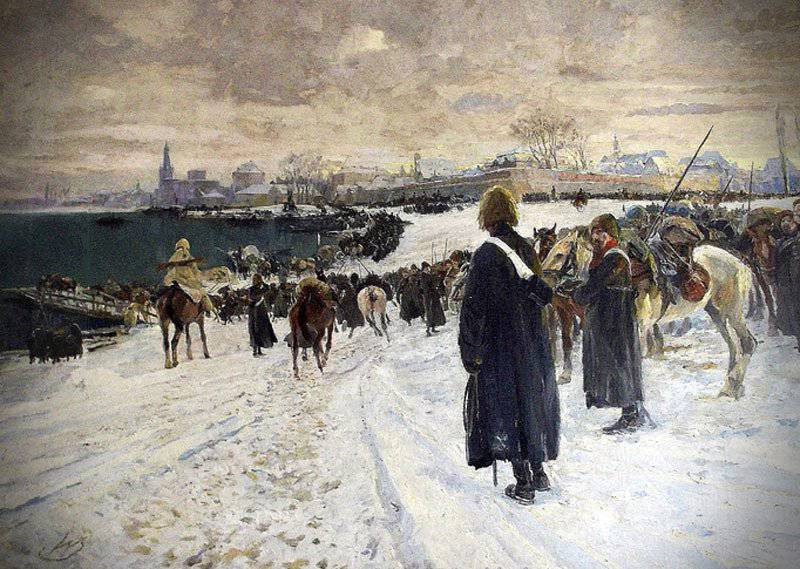
Russian troops at the crossing of the Rhine 13 January 1814. Hood Wilhelm Schreyer.
The invasion of France
On the 20 of December 1813, in the Basel area, Austrian, Bavarian and Wurttemberg troops from the Main Army invaded French territory. At the same time, the Silesian army also launched an offensive. 1 (13) January 1814, forced the Rhine and the Russian-Prussian forces. The main army moved to Langres, divided into nine columns: the five Austrian, Russian-Prussian, Austro-Bavarian corps Wrede, Wuerttemberg and Russian Wittgenstein. The offensive took place without any problems. Napoleon was not going to give decisive border battles. He simply had no strength for that. Small French troops retreated without a fight or after small clashes. However, it was necessary to block the French fortress, leaving large detachments for their siege. In addition, the Allies had to cover communications, flank. Gradually, the forces of the Allied army were dispersed, and Napoleon had the opportunity to concentrate his relatively small forces against separate enemy corps.
Marshal Victor received Napoleon's order to defend the passages through the Vosges. In December 1813, its corps was reinforced with 17-18 by thousands of recruits. But he sent almost all the reinforcements to reinforce the garrisons of the fortresses, so he had only about 9 thousand people at hand. Fearing to be surrounded by Strasbourg, he retreated to Savern, hoping there to gather all the forces of his corps and unite with the corps of Marmont. But the Silesian army dismantled the French corps, defending the Upper and Middle Rhine, so Victor went to Baccarat.
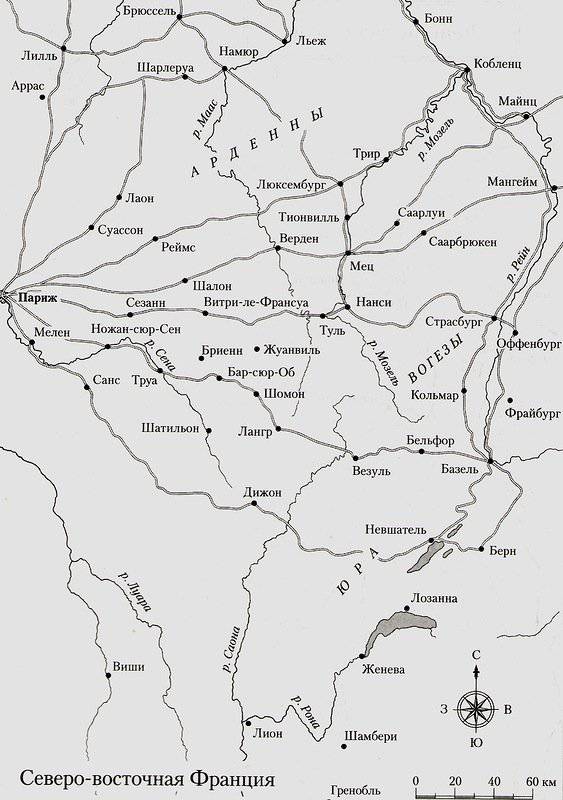
Allied forces fairly easily entered the Moselle valley. Napoleon expressed his displeasure to Victor. The French emperor ordered the transfer of the Old Guard from Namur to Reims, and then Langres. And also sent reinforcements to Nancy. The French continued to retreat. Victor retreated behind the Moselle, to join up with the corps of Marmont and Ney. In contact with the allied forces remained only the forces of Mortier. Marmont, who held the defense in front of the Silesian army, also retreated. First to Saarbrücken and Metz, then to the Meuse.
Thus, Napoleon’s hopes of keeping the Allied armies from invading deep into France were scattered. The small and poor quality of the French troops simply could not stop the superior forces of the enemy. In addition, the corps of Victor and Mamon, like the allied forces, could not establish interaction.
By January 26, the Allied forces, bypassing and enclosing the fortresses, gathered in the province of Champagne between the right tributaries of the Seine Marne and Ob, approximately 200 km east of Paris. However, they were not a single force, located on a large territory.
Napoleon's actions
Napoleon was in a dangerous position. Despite all his efforts to form a new army, the French troops were much inferior in number and quality to the Allied forces. Napoleon had on hand up to 70 thousands of people. The people, overwhelmed by the burden of numerous victims of previous years, conscripts and taxes, wanted peace. The population was seized with apathy, which was not shaken by the enemy invasion.
To free the troops who fought in Spain, Napoleon tried to make peace with her king Ferdinand VII, his former prisoner. He offered him freedom and the return of the throne, the withdrawal of all French troops from the peninsula in exchange for a break with the British and the withdrawal of their troops from Spain. With the success of the negotiations, Napoleon could get 80-100 thousand well-trained soldiers. However, negotiations were slow.
On the committee assembled to work out a country's defense plan, some generals suggested confining themselves to the enemy, deterring decisive battles with attempts to influence the flanks and the rear of the enemy. At the same time, readiness was expressed to give the enemy the Eastern departments and even Paris if military interests require it. So that the occupation of the capital by the enemy does not affect the defense of the country as a whole. However, Napoleon did not approve this plan. The loss of the east of the country and of Paris seemed to him too great a loss. He triumphantly passed all of Europe, now to yield to the enemy. In addition, the defensive strategy was not consistent with its usual mode of action. Napoleon preferred to attack. He decided, despite the weakness of his strength, to go towards the enemy, to seek good luck in battles. Initially, they wanted to strengthen Paris with field fortifications, placing them on the dominant heights, at the entrances of the suburbs. However, this idea was rejected, under the pretext of maintaining calmness among citizens.
Napoleon did not dare to raise the people against the invaders, which could be his hope of preserving the French throne. In particular, he reluctantly accepted the idea of calling national guards to defend the capital. Napoleon's brother, the former Spanish king Joseph, was appointed imperial deputy, commander-in-chief of the popular forces. King Joseph headed the 1 military district. In Paris, the main depot of the army was located: the 30 battalion personnel of the line troops, the 22 frame of the Young Guard. The artillery of the capital decided to reinforce 100 with guns from Chalon, 80 from Bordeaux, 50 from Brest. However, there was a shortage of gunners. Therefore, four companies of naval gunners were transferred from Cherbourg. Pupils of the Polytechnic School, veterans of the Four Guards Battalions, who were permanently stationed in Paris, should also have been trained in artillery.
The formation of the new army was going hard. Many eastern areas were lost before collecting recruits. 1812-1814 Concriptions gave about 80 thousand people instead of the expected 120 thousand people. Concriptions of previous years, no more than 30 thousand people. They were sent to replenish the corps of Marmont, Victor and Macdonald. Some of the recruits were sent to Belgium, others to Lyon, where they formed an army in order to close the roads from Switzerland and Savoy. Others gathered in Paris or formed a reserve for the troops operating in Spain. The lack of people made Napoleon make battalions of 400 people (out of recruits and 300 people), although the staff was 840 people.
The movement of the Main Army under the command of Schwarzenberg to Langres forced Napoleon to withdraw the Old Guard, which he sent to Belgium. The troops of Marmont, Mortier, Victor and Ney, only about 60 thousand people, were to detain the enemy in the valleys of the Seine and the Marne. They also had to connect MacDonald with 15 thousand soldiers. Napoleon himself went into the army from Paris to Chalon 13 (25) in January. He entrusted the management of public affairs to his wife, Marie-Louise. King Joseph was supposed to help her.
Before leaving for the army, Napoleon presents his son to the soldiers of the National Guard. French painter Felix-Emmanuel-Henri Filippoto
In the Vitry area, the 2 corps of Victor, the 6 of Marmon, the Ney guard, the cavalry corps of the 1 of Dumerian and 5 of Milgo were located. More than 40 thousand people with 120 guns. On the right flank, Mortier, part of the guard, was stationed at Troyes and Arsie, one of the divisions of the Paris reserve - more than 20 thousand. On the left wing, on the march from Namur to Chalon under the general command of Macdonald, were the 5 corps of Sebastiani, the 11 of MacDonald, the 2 of the cavalry of Exelman and the 3 of the cavalry of Arriggi. The number of this group was small - about 9 thousand people.
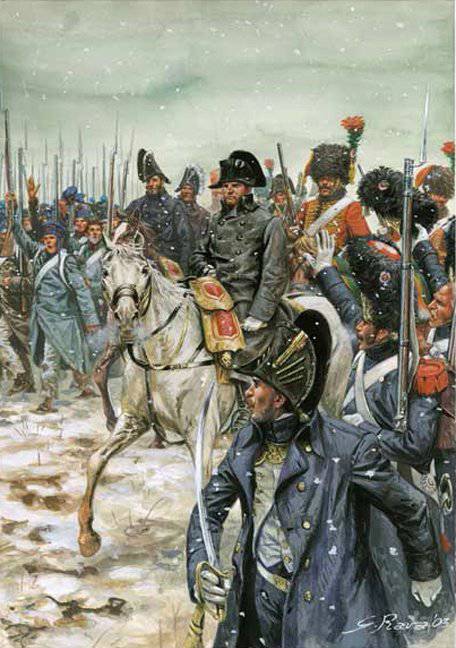
Long live the emperor! Italian artist Giuseppe Rava
The French emperor arrived at the 26 troops in January and decided to attack the allied forces. His actions facilitated disagreements between the allies. The Viennese court was not interested in the further offensive and through Schwarzenberg restrained the movement of the Allied armies. The Austrian emperor Franz and Metternich, fearing the predominance of Russia and the strengthening of Prussia, believed that the occupation by the Allied forces of a large part of France was enough to force Napoleon to peace. The Vienna court was ready to conclude an alliance against Paris with Paris. Metternich was able to incline to the idea of peace with France and some representatives of the Prussian elite. Thus, Prussian Chancellor Carl von Hardenberg was inclined towards peace. And the adjutant general of the Prussian king, Knesebeck, actively promoted the idea that the advance of the Allied armies to Paris would face the same difficulties that the Great Army of Napoleon experienced when advancing from Smolensk to Moscow. The British doubted. On the one hand, they did not want to strengthen Russia. On the other hand, they wanted to finish off Napoleon. Metternich's lines were followed by some Russian generals, Karl Nesselrode. Representatives of the South German lands also spoke in favor of peace.
However, Prussian Field Marshal Blucher was eager for Paris, and was supported by the Russian emperor Alexander, who was the main ideologue of the continuation of the war. Therefore, the main battles of the 1814 campaign unfolded between the Russian-Prussian corps of Blucher and Napoleon, while the main forces of the allies - the Main Army of Schwarzenberg - performed a supporting role. Napoleon decided to hit the enemy's advanced hull. The actions of Napoleon facilitated the scattered position of the allied forces. The allied army was stretched 280 versts.
Troop location on 27 January 1814
Battle of Brienne
The army of Blucher was divided. Russian corps of Alexander Langeron besieged frontier Mainz, the Prussian corps of York blocked the fortress of Metz and Luxembourg. Therefore, under the leadership of Blucher remained only the Russian corps of Fabian Osten-Sacken, who was nominated to Lemon on the River Ob; The 9 th infantry corps of Zakhar Olsufyev was located near Brien; Alexey Shcherbatov's forces were stationed at the town of Luzh on the River Ob; Sergey Lanskoy with the 2 th hussar division covered the communication line of the army of Blucher, which connected him with the corps of York. In addition, Blucher could get help from the Russian detachment of Count Peter Palen (1-Hussars Division with two Cossack regiments), which was the vanguard of the Main Army of Schwarzenberg. Blücher had around 25-30 thousand soldiers in total.
The closest thing to the army of Blucher, in Bar-sur-Habe, was the 3 th Austrian Corps of Guiolay (12 thousand people). The main apartments of the Union Monarchs and Schwarzenberg were located in Chaumont and Langres. Schwarzenberg arrived in Langres 6 (18) in January and stayed there for a week without showing a desire to continue the offensive.
Napoleon initially wanted to attack the flank of the Main Army, but after the success of Saint-Dizier, he decided to attack Blucher troops from the rear. On the morning of January 15 (27), Milgo's cavalry was able to catch unawares at the Hussar Lansky detachment in Saint-Dizier. Victor's infantry completed the success. Blucher’s troops were cut off from York Corps. Napoleon, having learned from the locals and prisoners about the extended position of the army of Blucher, decided to strike him. 16 (28) January French troops continued their movement in several columns. The guard went to Monterander; Victor with his corps and Milgo's cavalry along the Juanville road to Razhekur and then to Vassi; the troops of Gerard — the divisions of Ricard and Dufour, who were stationed in the vicinity of Vitry — marched towards Lemon and Brienne. Marmont's forces — the 6 Infantry and 1 Cavalry Corps — remained at Saint-Dizier.
The transfer of troops was difficult. Country roads intended for the carriage of the forest, soaked from the rain. The guns got stuck in the mud. Therefore, the troops passed by Monterander at night. Marmont launched the 17 (29) movement in January, leaving one division to cover Saint-Dizier. The main forces of Napoleon appeared at Brienna around 2 hours in the afternoon.
Russian troops are trying to recapture the castle in Brienne. 19th century engraving.
An unexpected blow to Blucher failed. Blucher, having received the report of Lansky, offered the corps of Giulai and Kronprinz of Württemberg to get close to him, and the Palen detachment to join the Silesian army. Lansky was instructed to monitor the roads leading to Joinville and Saint-Dizier. However, the new news forced Blucher to take the situation more seriously. Early in the morning on January 17 (29), the Cossacks delivered the captured French staff officer, Colonel Bernard, whom Napoleon sent to Marshal Mortier with the order to join the right flank of his army. From him learned information about the number and direction of movement of the French troops. The threat became apparent. Blucher then occupied Brienne with the forces of Olsufyev (5 thousand infantry and 24 guns) and ordered Saken to immediately withdraw to Brienne. Blucher did not consider it possible to stop Napoleon’s army and, having joined forces, was ready to withdraw to Bar-sur-Both, connecting with the nearest corps of the Main Army. The small corps of Olsufyev was reinforced by the detachment of Palen (2 thousand people). Detachment Palen covered Saken's corps from the flank, located in Lassikure. The detachment of Prince Shcherbatov (900 Cossacks, the Chuguev Lancers Regiment and the 4 Equestrian Guns) took up positions in Mezieres.
Schwarzenberg, having received news of the battle at Saint-Dizier, was more concerned about the situation of his army than the threat to the army of Blucher. He feared that he would be cut off from the Rhine and took steps to secure the right flank of the Main Army from the roundabout maneuver. The corps of Wittgenstein and Wrede (about 40 thousand people) were ordered to go to Joinville, and the corps of Guillai and the crown prince of Württemberg - to concentrate between Bar-sur-Haute and Chaumont.
At two o'clock in the afternoon, the French cavalry attacked the detachment of Prince Shcherbatov. Russian troops were pushed back to Brienne. To strengthen the defense of Brienna, with the loss of which Saken’s corps was cut off, Blücher ordered 4 and 34 regimental regiments from Palen's squadron to be positioned ahead of Brienna. Palen was also attacked by the superior forces of the French cavalry and began to retreat to Brienne.
At about four o'clock most of Saken’s corps approached Brienne. Only the large park behind the rear guard was behind. Because of the bad road, parts of Napoleon could not join the battle at the same time and entered into battle as they approached. Napoleon ordered the shelling of Brienne, and in the evening he organized a general attack. Ney's troops attacked in two columns, the division of Duhem from Victor's corps was advancing on the left flank, the special column of General Chateau was ordered to occupy the Brienne castle. All French cavalry was assembled on the right flank. Ney's soldiers broke into artillery positions, captured two guns and entered the city. The French dragoons almost killed Osten-Sacken himself, his convoy died, the quartermaster general of the corps was killed.
However, the situation was saved by Russian artillery. General Nikitin took 24 guns from the reserve, set them parallel to the mezierra road and opened heavy fire on the enemy’s flank. The French suffered heavy losses and withdrew, abandoning the captured guns. Having collected all the available cavalry, Palen overturned Victor's infantry in front of Napoleon. Russian cavalry seized 8 guns, but was able to lead only 5 guns.
Closer to the night, the French nearly captured Blucher and his generals. Brigade Chateau, having made a detour, a sudden attack seized the castle of Brienne. Blucher arrived there shortly before to explore the area. Blucher and Gneisenau were able to go top. It was almost captured Saken. French dragoons drove past him, not noticing him at dusk. This enabled the general to get out into the field and gallop away to the location of his troops.
Blucher tried to recapture the castle, which occupied a dominant position over the city. The attack went the troops of Olsufyev and Saken. The fierce battle continued until midnight. The French were knocked out of the burning ruins of the town, but they kept the castle. At the end of the battle. Blucher was not going to lead the battle to the last extreme. After a short rest, at 2 in the morning of January 30, Blücher began to withdraw troops to Tran, to join up with the Main Army.
It must be said that not only the Russian-Prussian command was exposed to danger in this battle. When the French emperor after the battle returned to his camp, his convoy was attacked by the Cossacks, penetrating the rear of the French. Napoleon personally had to fend off the Cossacks. The emperor's retinue was able to repel the attack.
Both armies in this battle lost thousands of people killed and wounded by 3. Several hundred people were taken prisoner. From the French side, Rear Admiral Pierre Bast fell in battle, divisional generals Deco and Lefevre-Denouette were injured.
The stubborn resistance of the Russian troops caused confusion among the French. The French command believed that Blucher would receive reinforcements at night and the battle would continue in the morning, with the numerical advantage already on the side of the enemy. In case of defeat, the French troops will have to retreat along bad roads, with the enemy in the cavalry. However, fears were in vain. Napoleon won up in the first major battle of the 1814 campaign of the year. The French army, with a considerable numerical superiority, forced the enemy to retreat, gained a tactical advantage. The morale of the French army, in large part consisted of unexperienced recruits, rose. However, the main task was not solved: the army of Blucher was not defeated. Already on February 1 a new battle will take place at La Rothiere, where Blucher will take revenge.
Cossack raid on Napoleon after the battle of Brienne. Lithograph of the XIX century
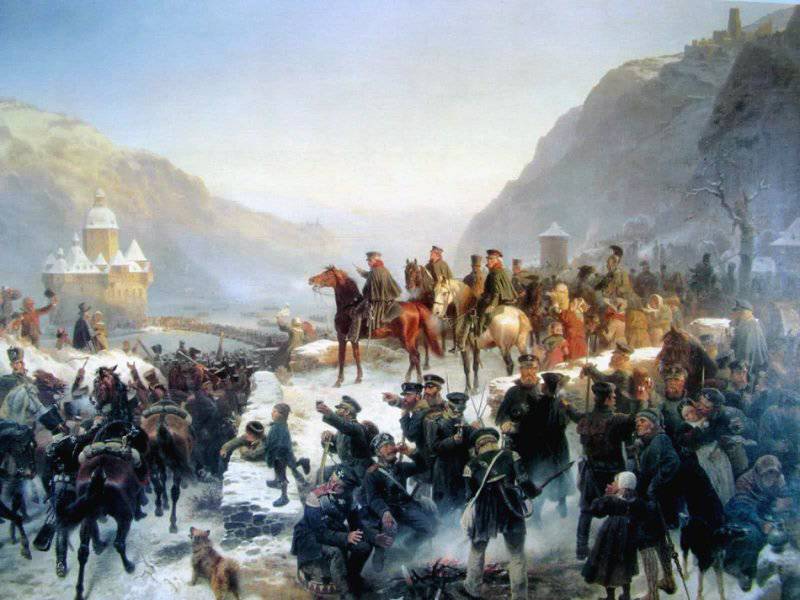
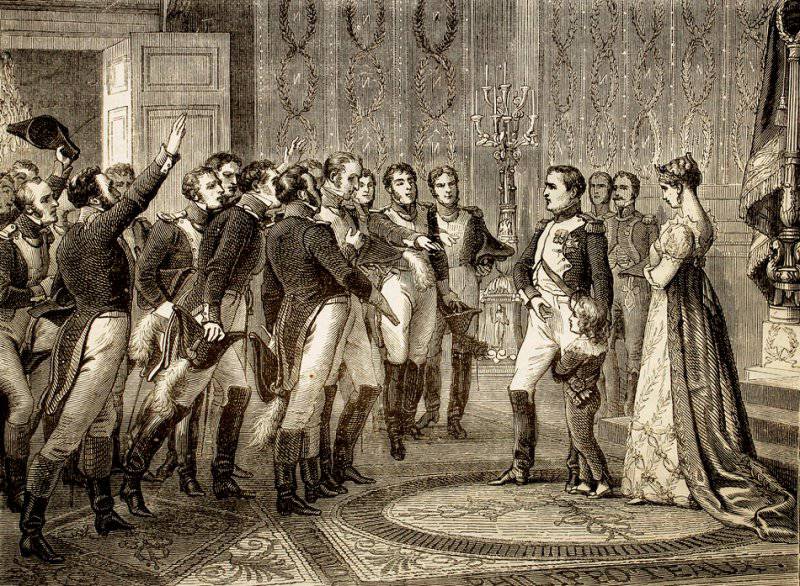
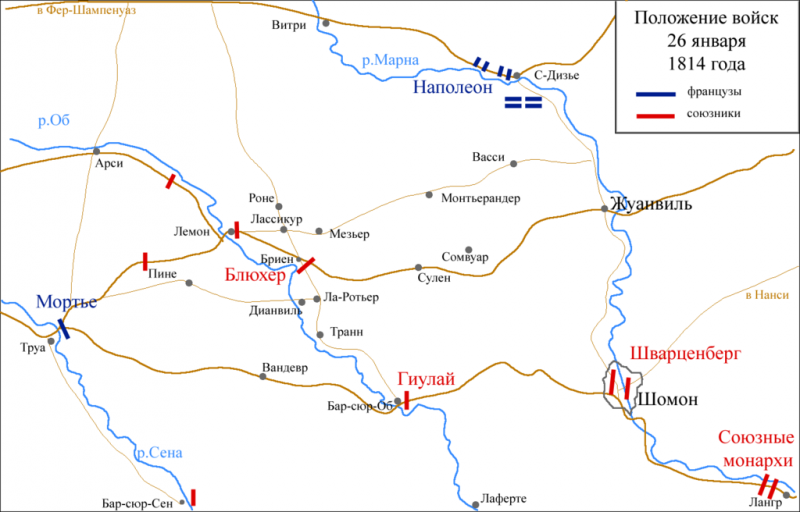
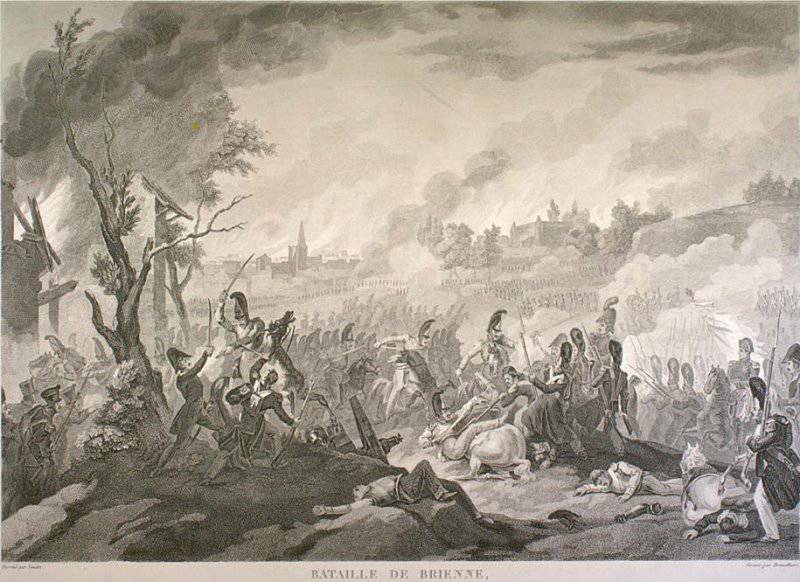
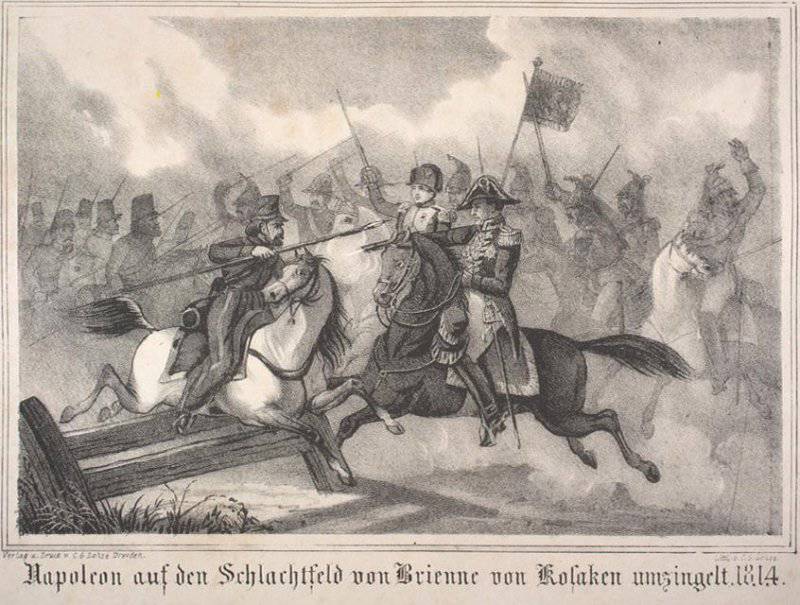
Information